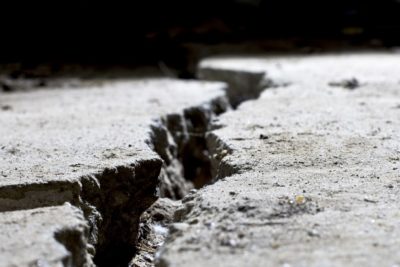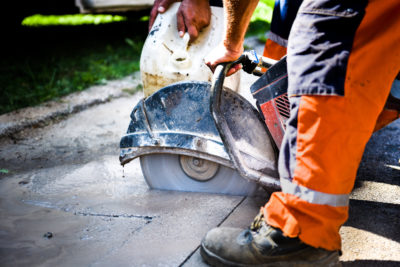If you’re considering using concrete cutting for your project but wondering whether it will be a good fit, we’ve got you covered. There are so many questions you could be asking yourself. What are cuts in concrete for? When should I use saw cuts in concrete? We’ve got the answers! Welcome to our complete concrete cutting guide.
First Things First: What Is Concrete Cutting?
In a nutshell, concrete cutting either removes or modifies a concrete slab. Since concrete is thicker and more robust than many other materials in construction, you have to approach concrete cutting in a unique way. If you want to make any improvements to your property and concrete is in the way, concrete cutting will be an essential step in the process.
Concrete control joints are created with saw cuts, which help prevent cracks from forming. Before any internal cracking starts to form, cuts should be made at a predetermined spacing only after the concrete has gained strength. Furthermore, you should only make saw cuts at the right time. And the time to make concrete cuts depends on many factors, including the admixtures and aggregates used in the concrete, the temperature, and the mix design.
What is Best for Cutting Concrete?
You can easily make a costly mistake without the right tools or expertise. Concrete cutting can be a highly technical process and, therefore, we recommend you use professional concrete cutting services.
What Are the Ideal Conditions for Concrete Cutting?
The concrete mix, weather conditions, concrete hardness, and cutting equipment used to make the saw cuts will all determine when you can cut concrete.
Cutting too early causes ravelling, leaving a messy, weakened edge along the cut. Furthermore, this also wears diamond concrete saw blades. On the other hand, sawing too late can result in uncontrolled cracking as the concrete shrinks during the curing phase.
Depending on the weather, saw cutting can start three to six hours after you’ve poured the concrete. Want to know when the slab is ready for concrete cutting? Make some trial cuts, then check for ravelling. Take note that your saw cutting should start as soon as the ravelling stops during these trial cuts.
Here are some other things that could cause excessive blade wear and joint ravelling:
- Pushing the blade too hard
- Saw cutting at a very high speed
- Using a saw with a bent spindle
- Using an inappropriate saw blade
When Do You Use Concrete Cutting?
So then, will concrete cutting work for your project? Well, here are some of the most commonly used scenarios and projects where concrete cutting is the most effective solution.
Wall Sawing
Wall sawing entails concrete removal because you’ll be cutting an opening into a block of existing concrete to add windows or doors. How does this work? Well, your professional concrete cutter will use a big diamond blade to cut through the wall, following a track on the wall.
Core Drilling
Core drilling entails drilling a perfectly round hole into a slab of concrete. This is often used for ventilating a furnace, plumbing, or repairing electrical work. Holes can be of different sizes, depending on what you need.
Wire Sawing
In this system, a diamond wire goes through a pulley system, running at high speeds to cut the concrete. Please note that only experienced professionals in large-scale jobs should use this method.
Slab Sawing
Slab sawing is like wall cutting, except that you cut into the floor instead of a vertical wall. For example, when you need to cut into concrete footings, bridges, roads, or anything flat, you’ll use a slab saw, walking behind the machine as it cuts into the surface of the concrete.
A common reason for slab sawing is plumbing repairs beneath a concrete surface or for concrete removal in construction projects.
What Is the Concrete Cutting Process?
How do you cut reinforced concrete? Well, you first need to analyse factors such as curing techniques, slab thickness, and base type before deciding where joints should be cut. Once you’ve laid out the joints to be cut, you should mark them using chalk.
If you’re using water cutting equipment, ensure the water runs down to the blade. Then, allow the blade to reach the required depth before walking or moving the equipment following the chalk mark.
Here are some tips when cutting concrete:
- Avoid twisting the saw blade
- Don’t let the blade spin in the cut, as this will increase wear on the bond
- When cutting concrete with heavy rebar, use cutters with soft metal segment bonds
- Always use the required personal protective equipment (PPE)
Essential Safety Tips
Our cutting tips are essential to keep you safe when drilling into concrete to avoid severe injuries and even death due to the uncontrollable kickback of the concrete saw.
However, there are four elements that you can control to reduce the chances of kickback.
The Concrete Cutter or Saw
- Never use a saw that is too heavy for you to operate safely
- Never try to remove the blade guard
- Avoid cutting with the upper front quadrant of the saw’s blade
- Only use the saw at the manufacturer’s recommended speed
The Blade
- Since dull blades are more likely to bind up in cuts, you must keep your blade sharp
- Keep your blade clean
- Avoid using tooth blades since these can increase the risk of kickback
- Don’t allow the blade to overheat
- Make sure your blade is the correct size for the saw
The Operator
- Wear your PPE
- Ensure you have had the proper training when it comes to the cutting techniques and how to hold the saw correctly and safely
- Maintain proper balance at all times and avoid sawing in strange positions
- Don’t stand directly behind the saw to reduce the chances of being struck if the saw kicks back
- Avoid long-term, repetitive cutting. If you cut while tired, you’ll stand closer to the saw and increase your risk of being struck
The Technique
- Be extra careful when cutting concrete
- Allow the saw to reach its optimal speed before starting the cut
- Although you might be tempted to, don’t lean into the cut. Leaning places you closer to the saw, making it more likely to be struck if the saw kicks back
- Only cut in straight lines
- Always take your finger off the trigger or power switch if the blade binds up, the saw stalls or the power is interrupted
Concrete Cutters Perth: Who Can Help with Your Concrete Cutting Project?
Contact the best concrete cutters in Perth for more information on the cost of concrete cutting or saw cutting in general. Diamond Cut Concrete specialises in all things concrete, from concrete coring and concrete removal to quick cut sawing concrete scanning.
Contact us today for help!



